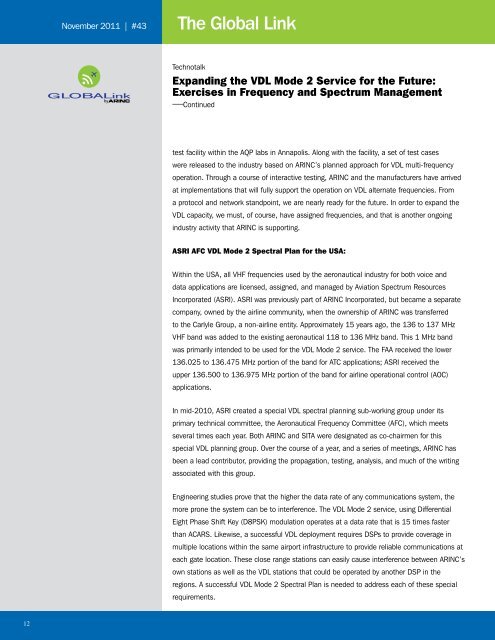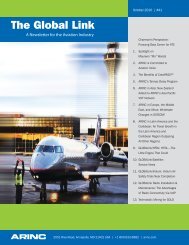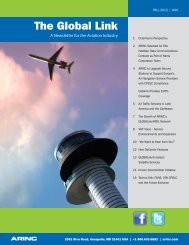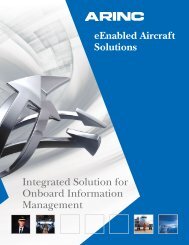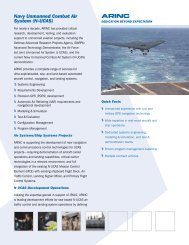The Global Link - Arinc
The Global Link - Arinc
The Global Link - Arinc
You also want an ePaper? Increase the reach of your titles
YUMPU automatically turns print PDFs into web optimized ePapers that Google loves.
November 2011 | #43<br />
<strong>The</strong> <strong>Global</strong> <strong>Link</strong><br />
Technotalk<br />
Expanding the VDL Mode 2 Service for the Future:<br />
Exercises in Frequency and Spectrum Management<br />
—Continued<br />
test facility within the AQP labs in Annapolis. Along with the facility, a set of test cases<br />
were released to the industry based on ARINC’s planned approach for VDL multi-frequency<br />
operation. Through a course of interactive testing, ARINC and the manufacturers have arrived<br />
at implementations that will fully support the operation on VDL alternate frequencies. From<br />
a protocol and network standpoint, we are nearly ready for the future. In order to expand the<br />
VDL capacity, we must, of course, have assigned frequencies, and that is another ongoing<br />
industry activity that ARINC is supporting.<br />
ASRI AFC VDL Mode 2 Spectral Plan for the USA:<br />
Within the USA, all VHF frequencies used by the aeronautical industry for both voice and<br />
data applications are licensed, assigned, and managed by Aviation Spectrum Resources<br />
Incorporated (ASRI). ASRI was previously part of ARINC Incorporated, but became a separate<br />
company, owned by the airline community, when the ownership of ARINC was transferred<br />
to the Carlyle Group, a non-airline entity. Approximately 15 years ago, the 136 to 137 MHz<br />
VHF band was added to the existing aeronautical 118 to 136 MHz band. This 1 MHz band<br />
was primarily intended to be used for the VDL Mode 2 service. <strong>The</strong> FAA received the lower<br />
136.025 to 136.475 MHz portion of the band for ATC applications; ASRI received the<br />
upper 136.500 to 136.975 MHz portion of the band for airline operational control (AOC)<br />
applications.<br />
In mid-2010, ASRI created a special VDL spectral planning sub-working group under its<br />
primary technical committee, the Aeronautical Frequency Committee (AFC), which meets<br />
several times each year. Both ARINC and SITA were designated as co-chairmen for this<br />
special VDL planning group. Over the course of a year, and a series of meetings, ARINC has<br />
been a lead contributor, providing the propagation, testing, analysis, and much of the writing<br />
associated with this group.<br />
Engineering studies prove that the higher the data rate of any communications system, the<br />
more prone the system can be to interference. <strong>The</strong> VDL Mode 2 service, using Differential<br />
Eight Phase Shift Key (D8PSK) modulation operates at a data rate that is 15 times faster<br />
than ACARS. Likewise, a successful VDL deployment requires DSPs to provide coverage in<br />
multiple locations within the same airport infrastructure to provide reliable communications at<br />
each gate location. <strong>The</strong>se close range stations can easily cause interference between ARINC’s<br />
own stations as well as the VDL stations that could be operated by another DSP in the<br />
regions. A successful VDL Mode 2 Spectral Plan is needed to address each of these special<br />
requirements.<br />
12


